2004 CHEVROLET CLASSIC coolant level
[x] Cancel search: coolant levelPage 228 of 348
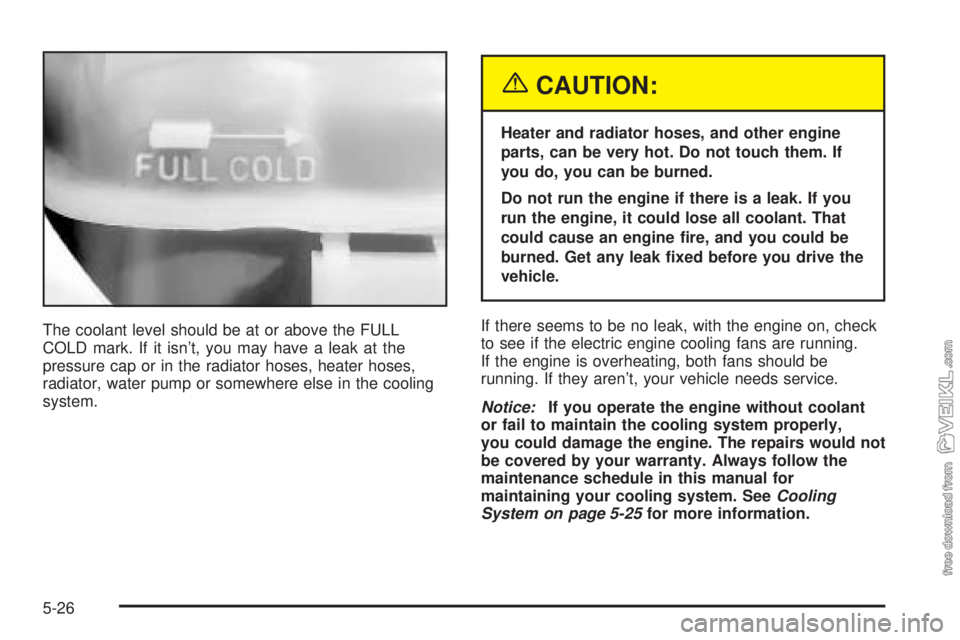
The coolant level should be at or above the FULL
COLD mark. If it isn’t, you may have a leak at the
pressure cap or in the radiator hoses, heater hoses,
radiator, water pump or somewhere else in the cooling
system.
{CAUTION:
Heater and radiator hoses, and other engine
parts, can be very hot. Do not touch them. If
you do, you can be burned.
Do not run the engine if there is a leak. If you
run the engine, it could lose all coolant. That
could cause an engine �re, and you could be
burned. Get any leak �xed before you drive the
vehicle.
If there seems to be no leak, with the engine on, check
to see if the electric engine cooling fans are running.
If the engine is overheating, both fans should be
running. If they aren’t, your vehicle needs service.
Notice:If you operate the engine without coolant
or fail to maintain the cooling system properly,
you could damage the engine. The repairs would not
be covered by your warranty. Always follow the
maintenance schedule in this manual for
maintaining your cooling system. SeeCooling
System on page 5-25for more information.
5-26
Page 229 of 348
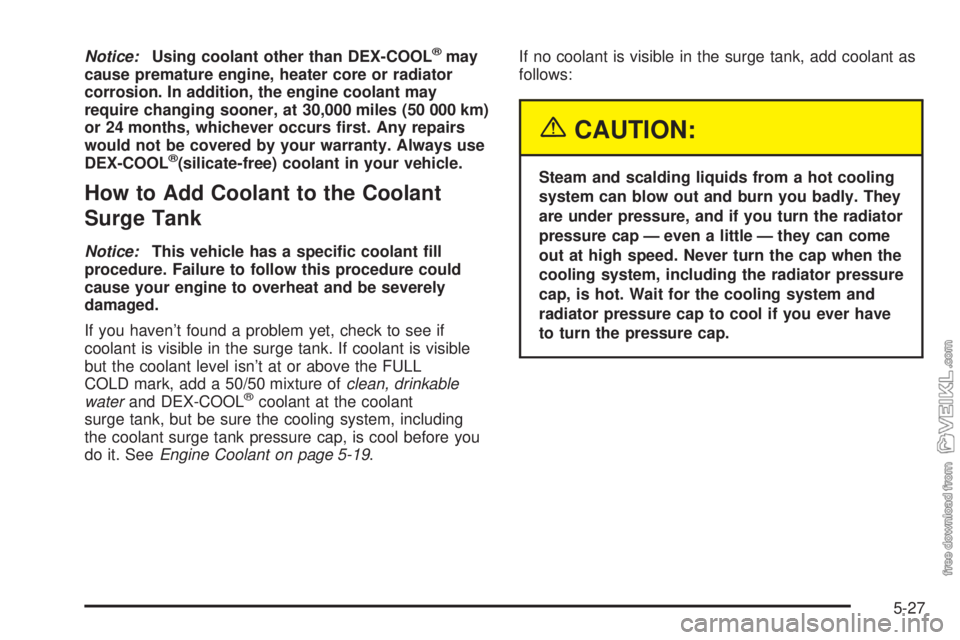
Notice:Using coolant other than DEX-COOL®may
cause premature engine, heater core or radiator
corrosion. In addition, the engine coolant may
require changing sooner, at 30,000 miles (50 000 km)
or 24 months, whichever occurs �rst. Any repairs
would not be covered by your warranty. Always use
DEX-COOL
®(silicate-free) coolant in your vehicle.
How to Add Coolant to the Coolant
Surge Tank
Notice:This vehicle has a speci�c coolant �ll
procedure. Failure to follow this procedure could
cause your engine to overheat and be severely
damaged.
If you haven’t found a problem yet, check to see if
coolant is visible in the surge tank. If coolant is visible
but the coolant level isn’t at or above the FULL
COLD mark, add a 50/50 mixture ofclean, drinkable
waterand DEX-COOL
®coolant at the coolant
surge tank, but be sure the cooling system, including
the coolant surge tank pressure cap, is cool before you
do it. SeeEngine Coolant on page 5-19.If no coolant is visible in the surge tank, add coolant as
follows:
{CAUTION:
Steam and scalding liquids from a hot cooling
system can blow out and burn you badly. They
are under pressure, and if you turn the radiator
pressure cap — even a little — they can come
out at high speed. Never turn the cap when the
cooling system, including the radiator pressure
cap, is hot. Wait for the cooling system and
radiator pressure cap to cool if you ever have
to turn the pressure cap.
5-27
Page 231 of 348
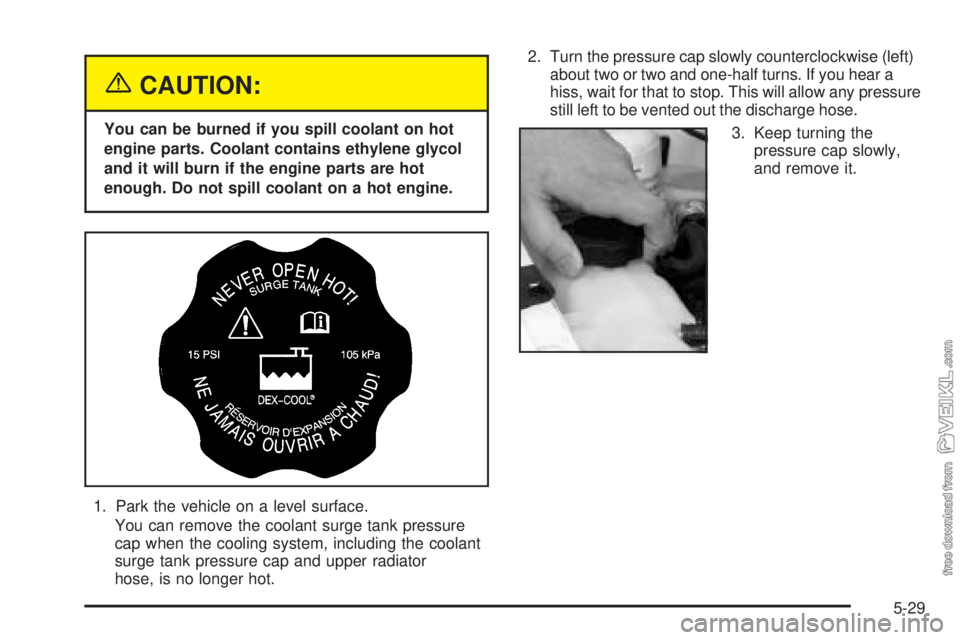
{CAUTION:
You can be burned if you spill coolant on hot
engine parts. Coolant contains ethylene glycol
and it will burn if the engine parts are hot
enough. Do not spill coolant on a hot engine.
1. Park the vehicle on a level surface.
You can remove the coolant surge tank pressure
cap when the cooling system, including the coolant
surge tank pressure cap and upper radiator
hose, is no longer hot.2. Turn the pressure cap slowly counterclockwise (left)
about two or two and one-half turns. If you hear a
hiss, wait for that to stop. This will allow any pressure
still left to be vented out the discharge hose.
3. Keep turning the
pressure cap slowly,
and remove it.
5-29
Page 232 of 348
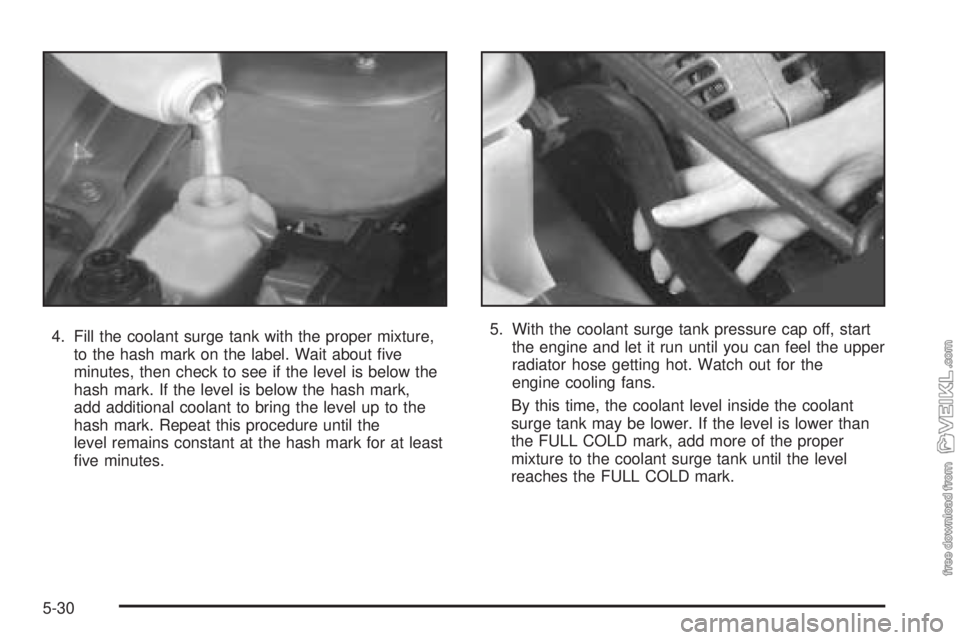
4. Fill the coolant surge tank with the proper mixture,
to the hash mark on the label. Wait about five
minutes, then check to see if the level is below the
hash mark. If the level is below the hash mark,
add additional coolant to bring the level up to the
hash mark. Repeat this procedure until the
level remains constant at the hash mark for at least
five minutes.5. With the coolant surge tank pressure cap off, start
the engine and let it run until you can feel the upper
radiator hose getting hot. Watch out for the
engine cooling fans.
By this time, the coolant level inside the coolant
surge tank may be lower. If the level is lower than
the FULL COLD mark, add more of the proper
mixture to the coolant surge tank until the level
reaches the FULL COLD mark.
5-30
Page 314 of 348
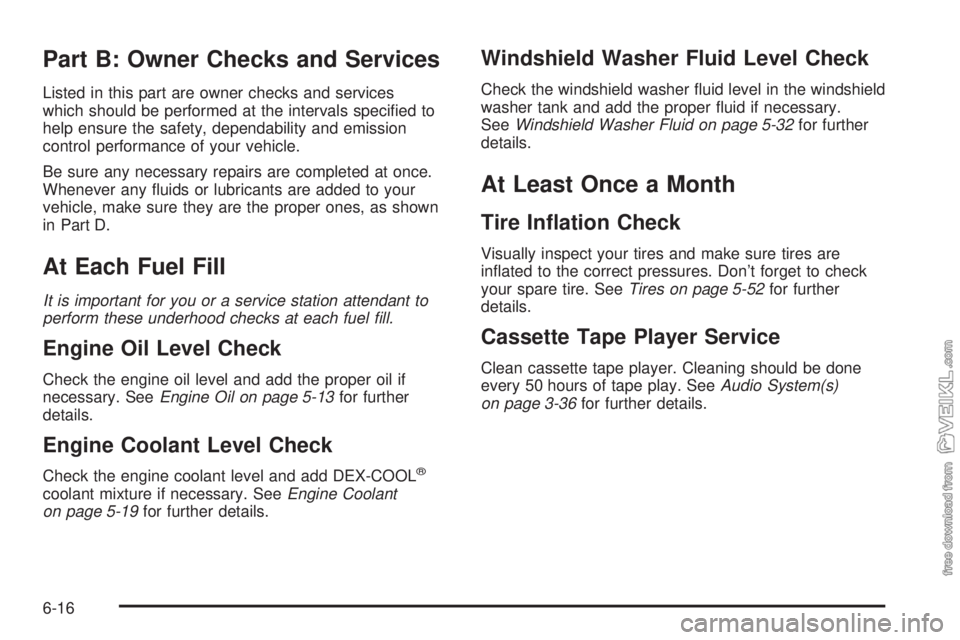
Part B: Owner Checks and Services
Listed in this part are owner checks and services
which should be performed at the intervals specified to
help ensure the safety, dependability and emission
control performance of your vehicle.
Be sure any necessary repairs are completed at once.
Whenever any fluids or lubricants are added to your
vehicle, make sure they are the proper ones, as shown
in Part D.
At Each Fuel Fill
It is important for you or a service station attendant to
perform these underhood checks at each fuel �ll.
Engine Oil Level Check
Check the engine oil level and add the proper oil if
necessary. SeeEngine Oil on page 5-13for further
details.
Engine Coolant Level Check
Check the engine coolant level and add DEX-COOL®
coolant mixture if necessary. SeeEngine Coolant
on page 5-19for further details.
Windshield Washer Fluid Level Check
Check the windshield washer fluid level in the windshield
washer tank and add the proper fluid if necessary.
SeeWindshield Washer Fluid on page 5-32for further
details.
At Least Once a Month
Tire In�ation Check
Visually inspect your tires and make sure tires are
inflated to the correct pressures. Don’t forget to check
your spare tire. SeeTires on page 5-52for further
details.
Cassette Tape Player Service
Clean cassette tape player. Cleaning should be done
every 50 hours of tape play. SeeAudio System(s)
on page 3-36for further details.
6-16
Page 337 of 348
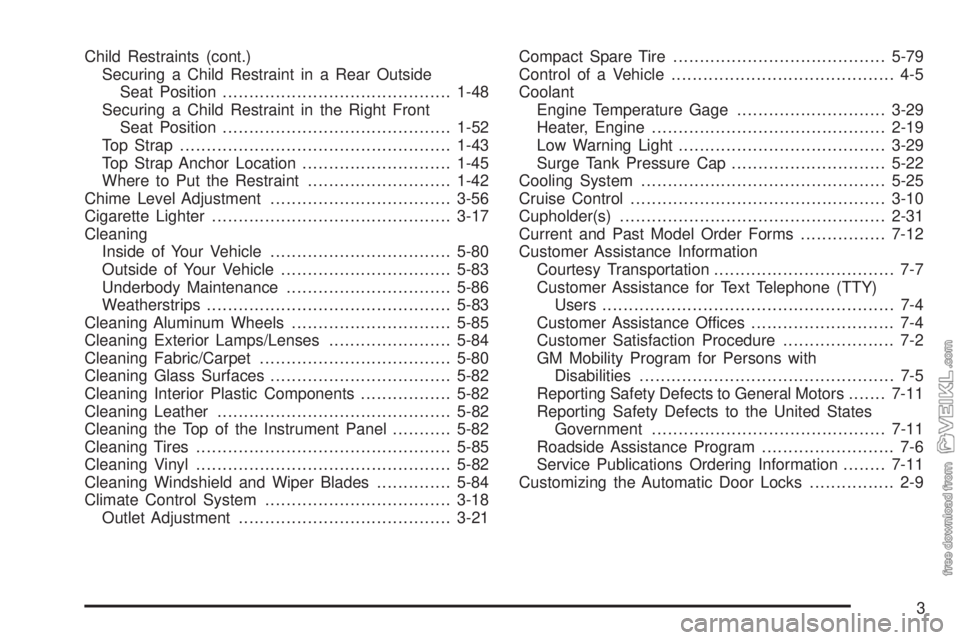
Child Restraints (cont.)
Securing a Child Restraint in a Rear Outside
Seat Position...........................................1-48
Securing a Child Restraint in the Right Front
Seat Position...........................................1-52
Top Strap...................................................1-43
Top Strap Anchor Location............................1-45
Where to Put the Restraint...........................1-42
Chime Level Adjustment..................................3-56
Cigarette Lighter.............................................3-17
Cleaning
Inside of Your Vehicle..................................5-80
Outside of Your Vehicle................................5-83
Underbody Maintenance...............................5-86
Weatherstrips..............................................5-83
Cleaning Aluminum Wheels..............................5-85
Cleaning Exterior Lamps/Lenses.......................5-84
Cleaning Fabric/Carpet....................................5-80
Cleaning Glass Surfaces..................................5-82
Cleaning Interior Plastic Components.................5-82
Cleaning Leather............................................5-82
Cleaning the Top of the Instrument Panel...........5-82
Cleaning Tires................................................5-85
Cleaning Vinyl................................................5-82
Cleaning Windshield and Wiper Blades..............5-84
Climate Control System...................................3-18
Outlet Adjustment........................................3-21Compact Spare Tire........................................5-79
Control of a Vehicle.......................................... 4-5
Coolant
Engine Temperature Gage............................3-29
Heater, Engine............................................2-19
Low Warning Light.......................................3-29
Surge Tank Pressure Cap.............................5-22
Cooling System..............................................5-25
Cruise Control................................................3-10
Cupholder(s)..................................................2-31
Current and Past Model Order Forms................7-12
Customer Assistance Information
Courtesy Transportation.................................. 7-7
Customer Assistance for Text Telephone (TTY)
Users....................................................... 7-4
Customer Assistance Offices........................... 7-4
Customer Satisfaction Procedure..................... 7-2
GM Mobility Program for Persons with
Disabilities................................................ 7-5
Reporting Safety Defects to General Motors.......7-11
Reporting Safety Defects to the United States
Government............................................7-11
Roadside Assistance Program......................... 7-6
Service Publications Ordering Information........7-11
Customizing the Automatic Door Locks................ 2-9
3
Page 339 of 348
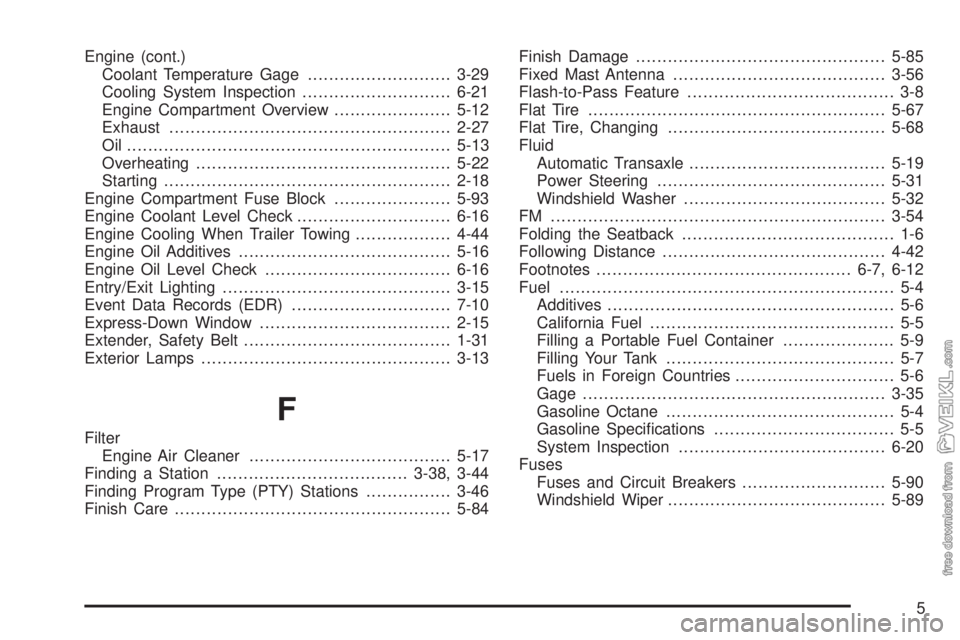
Engine (cont.)
Coolant Temperature Gage...........................3-29
Cooling System Inspection............................6-21
Engine Compartment Overview......................5-12
Exhaust.....................................................2-27
Oil .............................................................5-13
Overheating................................................5-22
Starting......................................................2-18
Engine Compartment Fuse Block......................5-93
Engine Coolant Level Check.............................6-16
Engine Cooling When Trailer Towing..................4-44
Engine Oil Additives........................................5-16
Engine Oil Level Check...................................6-16
Entry/Exit Lighting...........................................3-15
Event Data Records (EDR)..............................7-10
Express-Down Window....................................2-15
Extender, Safety Belt.......................................1-31
Exterior Lamps...............................................3-13
F
Filter
Engine Air Cleaner......................................5-17
Finding a Station....................................3-38, 3-44
Finding Program Type (PTY) Stations................3-46
Finish Care....................................................5-84Finish Damage...............................................5-85
Fixed Mast Antenna........................................3-56
Flash-to-Pass Feature....................................... 3-8
Flat Tire........................................................5-67
Flat Tire, Changing.........................................5-68
Fluid
Automatic Transaxle.....................................5-19
Power Steering...........................................5-31
Windshield Washer......................................5-32
FM ...............................................................3-54
Folding the Seatback........................................ 1-6
Following Distance..........................................4-42
Footnotes................................................6-7, 6-12
Fuel............................................................... 5-4
Additives...................................................... 5-6
California Fuel.............................................. 5-5
Filling a Portable Fuel Container..................... 5-9
Filling Your Tank........................................... 5-7
Fuels in Foreign Countries.............................. 5-6
Gage.........................................................3-35
Gasoline Octane........................................... 5-4
Gasoline Specifications.................................. 5-5
System Inspection.......................................6-20
Fuses
Fuses and Circuit Breakers...........................5-90
Windshield Wiper.........................................5-89
5